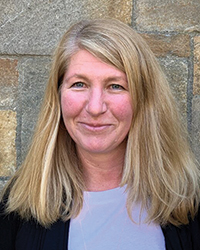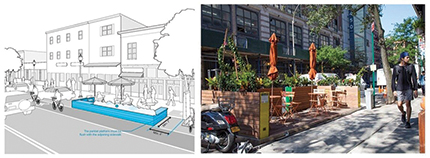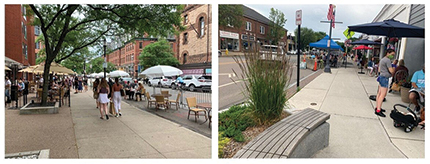



In the recent NY Times opinion piece about the benefits of banning individually owned cars in Manhattan, Farhad Manjoo touts the merits of wider sidewalks, more efficient public transit, healthier living, and generally more desirable public spaces that enhance and celebrate the pedestrian experience. The folks at the Practice for Architecture and Urbanism (PAU) have put together a very compelling visual and written argument for people taking back the streets of New York City. At Form + Place we have been thinking about how the Pandemic is shaping the way we use the spaces surrounding our homes, schools, and places of business. The picnic tables on the town common and pop-up outdoor restaurant seating on sidewalks offer a glimpse of a future streetscape that could be more appealing and socially inclusive. While we expect that vehicular traffic will ultimately return in most communities, it is worth giving some critical thought to the inherent possibilities of a re-imagined streetscape.
Already familiar with a handful of places (in Boston and beyond) that have closed off former streets to vehicular traffic, we know the joys of strolling and dining in the resulting bustling urban centers. Pedestrians brushing up against diners, people jostling with bicyclists, and goods brought out from shops to optimize their visibility and appeal, all contribute to a sense of vitality, which in turn draws crowds. This is an effective method to continue to employ as we re-vision our cities. In addition, guideline resources such as Complete Streets codify proven successful design interventions such as parklets and curb extensions.

Some will argue that parking spaces are a valuable commodity and the lifeblood of already precariously poised retail venues in small downtowns and villages. However when it comes to the ends of blocks where restaurants are often sited and where street crossings are most encouraged, the sheer volume of people and activity suggest that visible curb extensions, textural changes to paving, lighting accents and increased signage are all important parts of traffic calming and establishing pedestrian-focused hierarchy.
By applying this model to Newbury St. in Boston, or a suburban town center like Needham, it isn’t hard to imagine a different reality where a larger portion of the street is dedicated to pedestrians, dining and other activities rather than to moving and storing cars. The creative spontaneous response during the COVID crisis where small portions of “streets” are reclaimed for other uses has functioned as a real-time experiment, allowing us to easily imagine our typical street a little differently. Replace the jersey barriers, the traffic cones and temporary galvanized railings with design elements of the same function but better aesthetics, and the street quickly becomes a new kind of enjoyable place to dwell in and share.
Historically, it is only in the course of the last century that the street has come to be dominated by the presence of the privately owned automobile. In ancient and medieval times, streets were mostly narrow pathways between buildings, places to route water, goods and sewage, where crosswalks were constructed as literal river crossings.

The striking juxtaposition of photos of Park Ave. in NYC at the turn of the century and today (as seen in Manjoo’s NY Times article) is a dramatic accounting of good intentions gone awry by changing values. This is a perfect moment in time to reevaluate our intentions for the built environment of the future.
In many European cities, the “sidewalk and roadbed” are often barely distinct from one another, beyond a subtle change in paving. This reinforces an understanding that the street is a dynamic entity that can be re-purposed as needs dictate, and this idea is particularly intriguing. Could the future of our thoughtfully planned streets allow for the capacity to be literally dynamic?
Imagine a boulevard with limited vehicular traffic (perhaps busses and bikes, as PAU describes in their proposal for NYC) which would allow for restaurants and shops to engage the public more directly, and support increased amenities for the passer-by.
Traditionally the boundary between a street and a market is more implicit than explicit. An open market can take over a street at certain times a day with the barkers calling out to pedestrians.. At night shops shutter their doors and restaurants take the stage, extending their indoor atmosphere and alure to the world of the street.
At a moment when our commuting patterns have been adjusted, our emphasis on public gathering has been refocused, and we are poised to embrace equity in transportation, it’s important to see the temporary adjustments we’ve made to our streets as a first step toward a better design for our towns and cities. Yes, there will still be cars and stop lights and parking meters, but if a larger portion of the street is dedicated to pedestrians and activities of a more human scale, we can humanize our built environment a little more fully, reclaiming some of the real estate lost to our cars and creating a more equitable ownership of the public realm.
John Rufo, AIA, ICSC, is a principal and Gillan Wang, is a marketing and administrative associate at Form + Place, Newton Highlands, Mass.